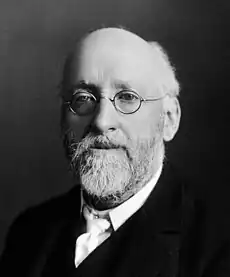William Maddock Bayliss
William Maddock Bayliss (2 de mayo, 1860, Wolverhampton - 27 de agosto, 1924, Londres) fue un fisiólogo inglés.[1]
| Sir William Maddock Bayliss | ||
|---|---|---|
 Sir William Maddock Bayliss | ||
| Información personal | ||
| Nacimiento |
2 de mayo de 1860 Wolverhampton, Staffordshire, Inglaterra | |
| Fallecimiento |
27 de agosto de 1924 64 años Londres Inglaterra | |
| Residencia | Reino Unido | |
| Nacionalidad | inglés | |
| Educación | ||
| Educado en |
University College de Londres Universidad de Oxford | |
| Información profesional | ||
| Área | Fisiología | |
| Conocido por |
Secretina Peristalsis | |
| Empleador | University College de Londres | |
| Miembro de | Royal Society | |
| Distinciones |
Medalla Royal, 1911 Medalla Copley, 1919 | |
Junto a Ernest Starling estudió la contracción y dilatación de los vasos sanguíneos que son controlados por los nervios, descubriendo por consecuencia la onda peristáltica. En 1902 demostraron que el ácido clorhídrico mezclado con alimentos parcialmente digeridos, activaba una sustancia química en el duodeno que llamaron secretina, debido a la secreción de jugo pancreático. Esto marcó el descubrimiento de las hormonas, un término que ambos acuñaron. Bayliss también expuso como la tripsina se formaba de tripsinógeno y cuantificó con precisión el tiempo que duraba digerir la proteína.
Referencias
- «Bayliss, William Maddock». Who's Who, 59: p. 114. 1907.
Fuentes
- Zárate, Arturo; Saucedo, Renata (2005), «[On the centennial of hormones. A tribute to Ernest H. Starling and William M. Bayliss]», Gaceta médica de México 141 (5): 437-9, PMID 16353891.
- Hirst, Barry H (2004), «Secretin and the exposition of hormonal control», J. Physiol. (Lond.) (15 October 2004) 560 (Pt 2): 339, PMC 1665254, PMID 15308687, doi:10.1113/jphysiol.2004.073056.
- Modlin, I M; Kidd, M (2001), «Ernest Starling and the discovery of secretin», J. Clin. Gastroenterol. (Mar 2001) 32 (3): 187-92, PMID 11246341, doi:10.1097/00004836-200103000-00001.
- Modlin, I M; Kidd, M; Farhadi, J (2000), «Bayliss and Starling and the nascence of endocrinology», Regul. Pept. (25 September 2000) 93 (1–3): 109-23, PMID 11033058, doi:10.1016/S0167-0115(00)00182-8.
- Svatos, J; Svatos, A (1999), «The divergence in the conception of Pavlov and Bayliss-Starling concerning the function of the nervous system», Ceskoslovenská fysiologie / Ústrední ústav biologický (Feb 1999) 48 (1): 22-6, PMID 10377602.
- Folkow, B (1989), «Myogenic mechanisms in the control of systemic resistance. Introduction and historical background», Journal of hypertension. Supplement : official journal of the International Society of Hypertension (September 1989) 7 (4): S1-4, PMID 2681587.
- Simmer, H H (1978), «[The discovery and the discoverers of secretin. A contribution to the history of science and to the typology of the scientist]», Die Medizinische Welt (15 December 1978) 29 (50): 1991-6, PMID 364247.
- Hill, A V (1969), «Bayliss and Starling and the happy fellowship of physiologists», J. Physiol. (Lond.) (September 1969) 204 (1): 1-13, PMC 1351589, PMID 4900770.
- Bayliss, L E (1961), «William Maddock BAYLISS, 1860–1924: life and scientific work», Perspect. Biol. Med. 4: 460-79, PMID 13688118.
Enlaces externos
 Wikimedia Commons alberga una categoría multimedia sobre William Maddock Bayliss.
Wikimedia Commons alberga una categoría multimedia sobre William Maddock Bayliss.- Corta biografía, bibliografía, y enlaces de fuentes en línea enVirtual Laboratory del Max Planck Institute for the History of Science
- The Bugle
- Biografía y bibliografía en Virtual Lab. del Max Planck Institute for the History of Science
Este artículo ha sido escrito por Wikipedia. El texto está disponible bajo la licencia Creative Commons - Atribución - CompartirIgual. Pueden aplicarse cláusulas adicionales a los archivos multimedia.